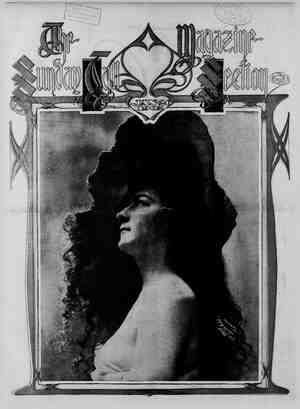The San Francisco Call. Newspaper, January 26, 1902, Page 13
You have reached the hourly page view limit. Unlock higher limit to our entire archive!
Subscribers enjoy higher page view limit, downloads, and exclusive features.
Charles HPRING =~ BONTINUED ~ Ackerman be- . ures modeled in bas-relief and nearly life size. Their semi-nudity allows the sculptor a fine opportunity to display his well known ability in delineating the human form. Although the layman may dmire the effects in this completed form, tist n appreciate the Aiffi- have been so ably worked bring that result. Every figure is ¢ life and energy and yet so ¥y modeled that in no place is more than three inches in 2 the morth wall is portrayed the spring, in the center panel of which is the Goddess of Spring (Fig. 1), flanked on either side by male figures represent- ing youthful Pans. Surmounting the buttresses, to the right and left of the center panel and over the mantel are satyr heads. The beautiful conception of harmony and love is deftly carried out THE SUNDAY CALL. 4 y| 3¢ ) Iy alh (A ( ) ] ) ! \ 21 ‘ Ol L. (7)) ] 1o B titul pastoral scene, the motlve of the three panels on this northerly wall being essentially that of youth and bounteous nature. These three panels are united in design by a background in which one may discern a fine suggestion of a landscape, whizh Is carried around the entire room, forming a connecting link with the vari- ous panels and gradually changing its aspect as one season merges into the next. Turning from the norgh wall to the east wall we behold the depiction of the summer season. The one to the left of the central panel shows the harvester and his wife (Fig. 4) before a primi- tive altar offering up their thanks for a bountiful harvest. On the other side of the central figure in this summer scene are shown the reapers (Fig. 5) at work. In the center of this group is shown the open book of life, which will be re- ferrad to later on A EARVESTYT WlooH~ 13 o iU Aa T10rd BE 3o YU mMes | S TSNy [F FYO 2 by the artist. In the spring pAnel to the Turning to the southerly wall the ;/ IHPRING IR IME - ~ BMONTINUED ~w \ o, T N S ST S ST 5 SRR — EAPERS BT M ORK BUuMMER MosTiIHUED=- R W] ' B "TER = Wlse Broseo Basiey ©OF Wrire-~-BEic W) 18 upholstered ed leather, which forms massive black oak at a height of e floor the frieze ex- e T for a distance of nis frieze, which is the the well known is symbolical of the f 1 The entire frieze pward of twenty or thirty fig- right of the central figure parents and children (Fig. 2) are disporting in mirth- ful glee, while at the side of the elder child is seen the crafty and agile chetah, one of the flercest of the beasts of the forest, and yet which has been trained to domesticity, and with gentle and placid spirit is mingling in the ball-tossing sport. On the other panel composing the in spring group (Fig. 3) is depicted a beau- autumn ecene is shown, which has for its of striking beauty and richness. Its cost. motif the grape. (Figs. 6 and 7.) Here we liness, however, will probably preciude its like being reproduced in many homes. The mechanical work of tinting and bronzing alone took three men more than four months, while the work of modeling in clay occupied Mr. Aitken's time for a much longer period. Art connoisseurs who have judged this frieze say that it will tax Aitken's genius ta the utmost to create a more sp! production. breast her little child, while near by an elder child is stirring the dying embers find the figures more mature in form and into a blaze. In this panel we find the appearance, and the apple blossoms of one fully draped figure, that of the moth- spring have been replaced by vines. In er. In the center of the winter panel the the center of this autumn scene is por- artist has presented the book of life, now trayed the harvest moon. (Fig.8) Onthe closed. These two panels—the book of westerly wall 1s the winter scene (Fig. §), life opened and closed, one set in the sum- which & mother bending over mer scene and the other in the winter— & sluggish fire of wood nestles to her stand in strong contrast and facing each other. (Figs. 10 and 11) They represent, respectlvely, the fullness of life and the bitterness of death. In each pahel the center is occupled by a small winged idol. In the summer group this figure holds in his hand the open tablets of life. On the sldes are, respectively, a male and a fe- male figure, each holding aloft an infant as if in thankfulness to the god of life. On the opposite side of the winter panel is reproduced the three main flgures, those upon the sides bending in sorrow and despair over funeral urns, which rest upon the altar in front of the idol, who now with bowed head closes in silence the book of life and clasps it tightly to his breast. In refined conception and poetic imagery these two panels have rarely, if ever, been excelled In sculpture. Taken &s a whole the effect of the frieze is one

